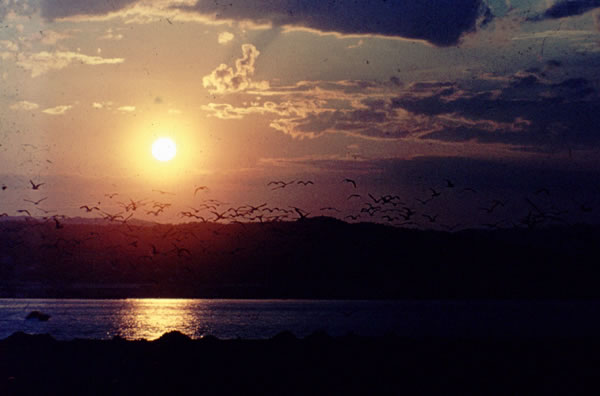Seasons and Sunsets Above the Arctic Circle: Predicting Sunsets
Before I take you north of the arctic circle, let us observe the sky as it appears here in [your city] in the middle of summer. It is noon.
How would you describe the position of the Sun?
[It is in the south but very high in the sky.]
Do you know where the Sun will set?
DIGITAL EFFECT: Go to Sunset Start the diurnal motion and let it run until sunset. Explain what the horizon markers do and have someone mark the position of the Sun as it sets.
DIGITAL EFFECT: Summer Night
Run diurnal motion until the Summer Triangle is high overhead. Presenters may need to adjust the exact time to match their theater’s own time zone.Let’s find the Big Dipper. It has seven bright stars in the shape of a pot or spoon.
The Big Dipper can help us find the North Star.
DIGITAL EFFECT: Big Dipper
Fade on a stick figure of the Big Dipper Pot.
DIGITAL EFFECT: Line to Polaris
Draw a line from the Big Dipper pointer stars to Polaris.
DIGITAL EFFECT: End Big Dipper
A group of stars that is familiar to stargazers at our latitude is called the Summer Triangle.
Can any of you find three bright stars overhead that form a large triangle?
DIGITAL EFFECT: Summer Triangle
Draw a triangle connecting the three stars of the Summer Triangle.
DIGITAL EFFECT: Go to Noon
Once the Summer Triangle has been located, move the Sun back to due south, the noon position (may vary based on your theatre’s location).
Optional: Have someone mark the sunrise.
DIGITAL EFFECT: End Summer Triangle
DIGITAL EFFECT: Local Noon
Run diurnal motion to local noon on June 22.Now I want to take you to 70° North. To do that we will find the star that is called the North Star, or Polaris. Other stars may seem to move, but this star always lies along a line that astronomers call the meridian.
DIGITAL EFFECT: Meridian
Fade on the meridian.The meridian stretches from the north to the south going directly overhead. In [YOUR CITY], which is at a latitude of [YOUR LATITUDE]° North, the north star is at an angle of [YOUR LATITUDE]° above the horizon.
Where would we see the north star if we traveled to Tromsø, which is at a latitude of 70°?
Formulate a rule with the audience about how high the north star is above the horizon when it is observed at different latitudes on Earth.
DIGITAL EFFECT: Tromsø North
Change the latitude to 70°, the coordinates of Tromsø, Norway, on June 22 at local noon, and note that the North Star is almost straight above our heads. Put the atmosphere and Sun on.
DIGITAL EFFECT: End Meridian
Fade meridian off.This is the position the Sun would be in at noon in the middle of summer in Tromsø.
What is different from what we saw in [YOUR CITY]?
[The Sun is lower.]
Will it set in the same direction as it did in [YOUR CITY], or further to the south, or further to the north?
Invite visitors to answer this question by hanging up horizon markers to mark their predictions.Let us start the daily motion of the Sun and see if it sets close to anyone’s marker.
DIGITAL EFFECT: Tromsø Sunset
Start the diurnal motion to see where the Sun “sets” on the summer solstice at Tromsø. Run until local noon.We can already see that the Sun’s path across the sky is much more flat than it was in [YOUR CITY]. It passes the western horizon, it passes the direction it set in [YOUR CITY], and it goes all the way to the north, closer and closer to the horizon, but it does not set at all!
What should we call a Sun that is up and shining all night?
VISUAL 2 (still): The Midnight Sun in Tromsø

This is the midnight Sun in Tromsø. We found the Summer Triangle earlier, but this name is not well known to the people who live north of the arctic circle.
Can you figure out why?
[There are no stars to be seen from the last days of April to the first days of August.]
Fade off the Midnight Sun in Tromsø.
It is not quite true, then, that the Sun always rises in the east and sets in the west. For people who live far to the north (or to the south) the direction of the sunrise and sunset depends on the time of the year. In the summer, in the arctic, it does not set at all. Then, at the beginning and at the end of the summer, the Sun rises and sets almost due north.
DIGITAL EFFECT (optional): Northern Sunrise
DIGITAL EFFECT (optional): Western Sunset
Show the sunset point on the horizon on the equinox (due west).

